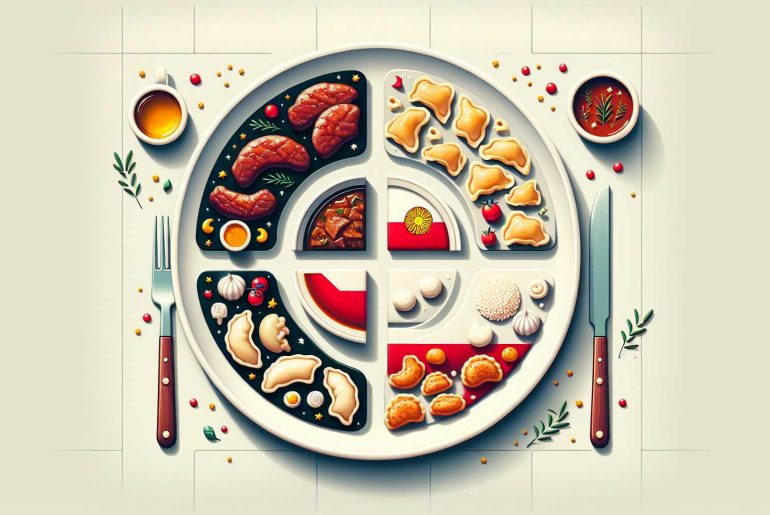
When we dive into Polish and Czech cuisines, we find a world of flavors and traditions shaped by each country’s history and culture. So, what makes these cuisines similar or different, especially when we look at staple ingredients, famous dishes, and how they celebrate with sweets, beer, and spirits? Poland is known for its filling, meat-heavy meals, while the Czech Republic often adds spices and sauces to its dishes, making for an interesting comparison.
As we explore further, we’re curious to see what brings these cuisines together and what makes them unique.
Historical Culinary Roots
Exploring the culinary history of Poland and the Czech Republic, we find a fascinating blend of influences shaped by centuries of history and geography. The flavors and traditions of these cuisines have been influenced by neighboring countries like Germany, Austria, Hungary, and even distant connections with the Ottoman Empire. This mix has created a diverse range of dishes unique to each country.
For example, consider the popular Polish dish, pierogi, and the Czech favorite, svíčková. Both reflect a blend of local and foreign culinary traditions. Pierogi, a type of dumpling, can be filled with a variety of ingredients ranging from potatoes and cheese to more gourmet fillings like mushrooms or fruit. Svíčková, on the other hand, is a marinated beef dish served with a creamy sauce and bread dumplings, showcasing a different aspect of the region’s culinary diversity.
The changing seasons also played a crucial role in shaping these cuisines. Before the advent of modern refrigeration, preserving food through pickling and smoking was essential. These techniques not only ensured that people had food throughout the year but also added new flavors and textures to the cuisine. Today, dishes like smoked sausage in Poland and pickled cucumbers in the Czech Republic are not just about preservation but are cherished for their taste and cultural significance.
In a nutshell, the culinary traditions of Poland and the Czech Republic are a testament to the resilience and creativity of their people. Through centuries of change, they have managed to retain their unique character while also embracing the influences that have come their way. Whether it’s the hearty comfort of a Polish bigos (hunter’s stew) or the delicate flavors of a Czech koláč (fruit pastry), these cuisines offer a delicious journey through history and culture. So next time you’re exploring new foods, why not dive into the rich tapestry of Polish and Czech cuisines? You might just find your new favorite dish.
Staple Ingredients Compared
Exploring the culinary traditions of Poland and the Czech Republic reveals some interesting similarities and differences, mainly because of their shared history and geography. Both countries enjoy using potatoes, cabbage, and meats like pork and beef in their dishes. This shows how the region’s farming and culture have influenced their food. However, there are some unique aspects to each cuisine.
In Poland, you’ll find a lot of dairy products in the mix. Cheese and sour cream are pretty common, which points to the country’s strong dairy farming practices. This means that if you’re enjoying a Polish meal, you might encounter dishes that are creamy and rich, thanks to these dairy additions.
On the other hand, the Czech Republic has a special place for dumplings in its cuisine. Czechs also use hops and malt in their cooking, not just in their famous beers. This brings a unique flavor to their dishes, reflecting the country’s long history of brewing. So, when you’re eating Czech food, expect to taste the influence of their beer-making traditions in their meals.
These differences in staple ingredients between the two countries highlight how geography, economy, and culture shape what people eat. For anyone looking to dive deeper into these cuisines, trying out dishes with these ingredients is a great start. For example, you could sample some Polish pierogi filled with cheese or enjoy a hearty Czech goulash served with dumplings. These dishes offer a taste of how each country brings its unique flavors to the table, using their staple ingredients.
Iconic Dishes Face-Off
Exploring the iconic dishes of Poland and the Czech Republic offers a glimpse into each country’s unique culture and history through their cuisine. In Poland, Pierogi stands out as a staple food. These are dumplings that come with various fillings, showcasing Poland’s agricultural heritage and its people’s communal way of life. They can be stuffed with anything from potatoes and cheese to fruits for a sweet treat, making them versatile and widely loved.
On the other hand, the Czech Republic is famous for Svíčková na smetaně. This dish features marinated beef sirloin in a creamy vegetable sauce, highlighting the Czech preference for hearty, meat-based meals. The complexity of its flavors reflects the rich culinary tradition of the country.
While Pierogi and Svíčková na smetaně differ significantly in terms of ingredients and preparation methods, both represent the soul of their respective cuisines. They underscore the importance of comfort food in bringing people together and keeping cultural traditions alive. This comparison sheds light not only on the differences between Polish and Czech cuisines but also on their common values, such as the significance of family gatherings and the preservation of culinary heritage.
In a more conversational tone, it’s fascinating to see how these dishes, so different at first glance, actually share a common thread: they’re both comfort foods at heart, deeply rooted in their countries’ traditions. Whether it’s the versatile Pierogi or the rich Svíčková na smetaně, both dishes have a special place in the hearts of their people, bringing families together and keeping their cultural legacy vibrant. It’s this shared love for food that bridges the gap between cultures, revealing that at the end of the day, we all cherish the warmth and connection that a good meal can bring.
Pastry and Dessert Delights
Exploring the sweet side of Polish and Czech cuisine reveals a fascinating array of pastries and desserts. Both cultures bring their unique traditions and innovations to the table, creating memorable culinary experiences. Let’s dive into some standout examples from each country.
In Poland, one cannot overlook the popularity of pączki. These are not just any doughnuts; they’re a special treat often filled with rose hip jam or prune preserves. What makes them particularly appealing is their deep-fried goodness, a method that adds an irresistible texture. Another Polish favorite is the szarlotka. This apple cake perfectly demonstrates how Poles make excellent use of local fruits, baking them into delicious desserts that are hard to resist.
Moving over to the Czech Republic, the koláče takes the spotlight. This pastry is incredibly versatile, with fillings ranging from poppy seeds and cheese to various fruits. It’s a clear example of Czech pastry-making skills, offering something for everyone’s taste. Then there’s the trdelník, a unique spit cake that’s often rolled in sugar and nuts. It’s a creative twist on traditional baking methods, resulting in a crunchy, sweet treat that’s become popular among locals and tourists alike.
Both Polish and Czech desserts not only satisfy the sweet tooth but also tell stories of cultural heritage and culinary innovation. Whether it’s the deep-fried delights of Poland or the versatile pastries of the Czech Republic, these sweets offer a delightful glimpse into the rich culinary worlds of both countries. Next time you’re in the mood for something sweet, why not try making a szarlotka or koláče at home? It’s a great way to experience these cultures’ flavors and traditions.
The Role of Beer and Spirits
Exploring the cultural landscapes of Poland and the Czech Republic, it’s clear how essential beer and spirits are. These beverages are much more than just drinks; they’re a reflection of history, tradition, and national pride. In Poland, vodka isn’t just alcohol; it’s a symbol of the country’s heritage. The art of vodka production, with its secret recipes and meticulous processes, is a matter of national pride passed down through generations. On the other hand, the Czech Republic is famous worldwide for its beer, especially the iconic Pilsner. This beer not only tastes great but also plays a significant role in the country’s economy and social life.
Let’s dive deeper into this. Polish vodka is known for its variety and quality. Brands like Belvedere and Zubrówka come with stories that blend history with modern-day craftsmanship. They show how traditional methods can create premium products that are celebrated both locally and internationally. Similarly, the Czech Republic’s Pilsner Urquell, with its golden color and refreshing taste, is more than just a beer. It’s a testament to the country’s brewing legacy, one that has set standards for what a good beer should be like worldwide.
These beverages tell a story of respect for tradition and a commitment to quality that goes beyond borders. For Poles, vodka is not just an alcoholic drink; it’s a part of culinary traditions and family celebrations. In the Czech Republic, beer is similarly integral to daily life and national identity. It’s common to see people from all walks of life enjoying a pint in Prague’s historic pubs, sharing stories and making memories.
Both Poland and the Czech Republic demonstrate a deep connection to their alcoholic beverages, highlighting their role in shaping national identities and cultural practices. Whether it’s a bottle of finely crafted Polish vodka or a pint of Czech Pilsner, these drinks are a source of pride and a reminder of the rich histories and traditions that have shaped these societies.
Conclusion
Looking closely at Polish and Czech food, we see how history, common ingredients, and cooking methods shape each cuisine. Even though Poland and the Czech Republic are neighbors and you might think their foods are very similar, they actually have quite a few differences.
From special dishes to sweets and the role of beer and spirits, each cuisine stands out on its own. This comparison shows us just how diverse and unique Central European food culture is. It’s interesting to see how each country brings its own flavor to the table.







Comments are closed.